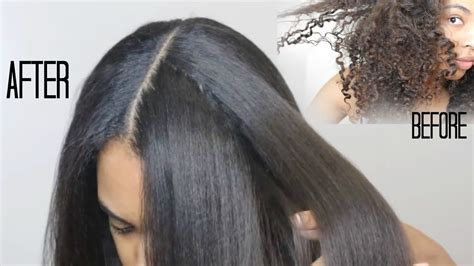Embracing Your Curly Essence
Are you pondering the transformative power of a curly hair relaxer? With over 65% of the world’s population sporting curly hair, you’re part of a vast and diverse community embracing the beauty of coils, waves, and ringlets. However, managing curly hair can be a journey filled with both joy and challenges.

The Science Behind Curly Hair Relaxers
Curly hair derives its unique structure from the shape of the hair follicle. Oval-shaped follicles in straight hair produce a smooth shaft, while elliptical-shaped follicles in curly hair create a curved shaft. This curvature is what gives curly hair its distinctive texture, volume, and personality.
Understanding Relaxers
Curly hair relaxers, also known as chemical hair straighteners, are chemical treatments that alter the hair’s structure to create a straighter, smoother appearance. These products typically contain sodium hydroxide, calcium hydroxide, or guanidine hydroxide, which break down the bonds within the hair shafts, allowing them to be reshaped.
Types of Relaxers
Relaxers come in three main types:
- Lye relaxers: The strongest type, containing sodium hydroxide or calcium hydroxide, which provide the most dramatic straightening results.
- No-lye relaxers: Contain guanidine hydroxide, which is gentler on the hair but may not produce as straight results as lye relaxers.
- Low-lye relaxers: A compromise between lye and no-lye, containing a lower concentration of sodium hydroxide or calcium hydroxide for milder straightening results.
Step-by-Step Relaxing Process
The relaxing process involves several steps:
- Pre-treatment: The hair is thoroughly washed and conditioned to prepare it for the chemical treatment.
- Application: The relaxer is applied to the hair in sections, and a protective cap is worn to prevent chemical burns.
- Processing: The relaxer is left on for a specified period to break down the hair bonds, typically 15-30 minutes.
- Neutralization: A neutralizing solution is applied to stop the chemical reaction and restore the hair’s pH balance.
- Rinse: The hair is thoroughly rinsed and conditioned to remove any remaining chemicals.
Benefits of Curly Hair Relaxers
Relaxers can provide several benefits, including:
- Reduced frizz and tangles: Relaxers smooth the hair shafts, making them less prone to tangles and frizz.
- Increased manageability: Straightened hair is easier to comb, style, and detangle.
- Versatile styling options: Relaxers open up a wider range of styling possibilities, from sleek and straight to soft waves and curls.
Considerations Before Relaxing
Before choosing to relax your hair, consider the following:
- Damage: Relaxers can weaken the hair and make it more prone to breakage and damage. It’s important to follow the instructions carefully and use a protein-rich conditioner to strengthen the hair.
- Hair type: Relaxers are most effective on coarse, curly hair and may not produce satisfactory results on fine or delicate hair.
- Chemical sensitivity: Some people may experience an allergic reaction to relaxers. Always do a patch test before applying the relaxer to the entire head.
- Long-term effects: Relaxers permanently alter the hair’s structure, so it’s important to consider the long-term consequences before making a decision.
Alternative Hair Straightening Methods
If you’re hesitant about relaxers, there are alternative hair straightening methods to consider:
- Keratin treatments: Less damaging than relaxers, keratin treatments use a protein called keratin to smooth the hair without altering its structure.
- Heat styling: Using heat tools like flat irons and curling wands can temporarily straighten hair, but it’s important to use heat protectant to avoid damage.
- Brazilian blowouts: A semi-permanent treatment that uses a straightening solution and heat to smooth and condition the hair.
Empowering Your Curly Journey
Whether you choose to relax your hair or embrace your natural curls, it’s important to empower yourself with knowledge and care for your hair. Listen to your hair’s needs and consult with a professional stylist for guidance and support.
Frequently Asked Questions (FAQs)
Q: How often should I relax my hair?
A: The frequency of relaxers depends on hair growth and the desired level of straightness. Most people relax their hair every 6-8 weeks.
Q: What are the side effects of relaxers?
A: Relaxers can cause damage, breakage, scalp irritation, and, in rare cases, hair loss.
Q: Can I relax my hair at home?
A: It’s not recommended to relax your hair at home unless you’re an experienced professional. Improper application can lead to serious damage.
Conclusion
Curly hair relaxers can be a transformative tool for those seeking a smoother, straighter look. However, it’s crucial to understand the science behind them, consider your hair type and condition, and make an informed decision. By empowering yourself with knowledge and seeking professional guidance, you can enhance the beauty of your curly hair journey.
